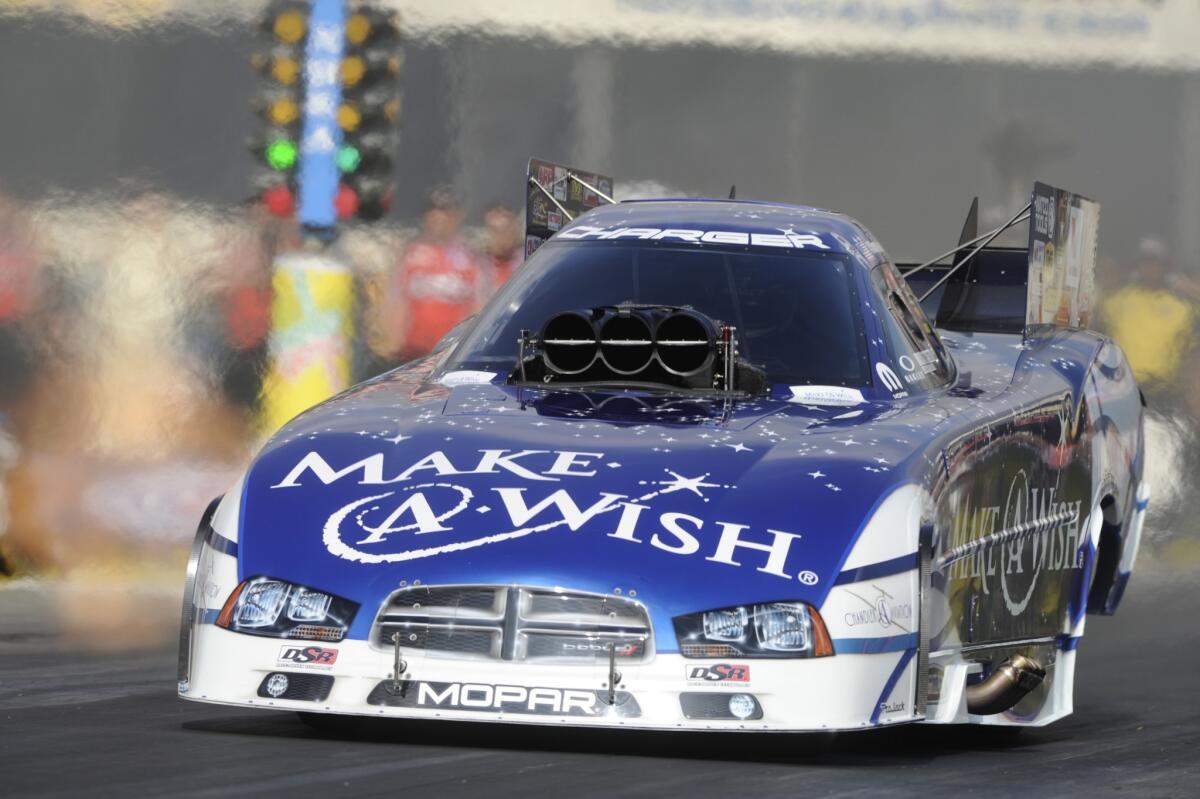NHRA drag racing looks to shorten breaks from fast action to draw fans

- Share via
In between qualifying rounds Friday, drag racer Jack Beckman signed autographs at the open-air pit area at Auto Club Raceway, including one for 9-year-old Max Leon of Whittier.
Max’s father, Joseph Leon, said that’s one reason he brought his son to the NHRA Finals at the Pomona dragstrip.
“He really loves that he can meet the drivers,” who often are available to fans passing by their pit stalls, the elder Leon said. “We’ve taken him to NASCAR [races] and he fell asleep.”
Big-league drag racing is a niche sport whose popularity has been steady in recent years. As the three-day NHRA Finals got underway in Pomona, the National Hot Rod Assn. aims to recruit more fans such as the Leons by making changes, including having more of its key races televised live instead of on a delayed basis.
The sport’s two most popular classes are top-fuel dragsters and funny cars (which Beckman drives) in the Mello Yello Series, which holds 24 events in 21 cities each season.
Dubbed nitro cars because their 8,000-horsepower engines are fueled with nitro methane, the two types of cars top 300 mph in a scant four seconds or less in 1,000-foot races.
While the NHRA doesn’t release figures, attendance has risen about 3% a year in each of the last two years and is on pace to grow by at least that amount again this year, NHRA President Tom Compton said.
Auto Club Raceway’s grandstands hold about 38,000, and the Finals’ three days — two days of qualifying and Sunday’s final eliminations — draw roughly 100,000 overall to Pomona.
Leading into Pomona, the sport’s average TV rating this year climbed to 0.4 from 0.3 a year earlier, and average household viewership was up 7% to 559,000 from 522,000, according to Nielsen figures released by ESPN, which carries NHRA racing.
NASCAR races, by contrast, draw a TV audience roughly seven to 10 times larger. But NASCAR has suffered substantial attendance and ratings declines since peaking in the mid-2000s.
One problem for the NHRA is that most of its events are tape-delayed on TV. That’s because, while each of its races are finished in the time it takes to read this paragraph, there can be lengthy delays between each race.
Teams need time to rebuild the dragsters’ engines between runs, and there are frequent delays to clean up “oil downs,” when oil drops on the dragstrip from blown engines. The NHRA believes it’s crucial to curb those problems to provide more events live on TV.
That’s especially pertinent with modern technology. Fans can learn an event’s results immediately with smartphones and social media, paring the need to watch the races two hours later on TV. But it’s TV that often brings in new fans.
So this year, the NHRA and ESPN agreed on showing three events live, and they’re hoping to show six events live next year.
“If it’s six, my nature is to push for seven,” said Don Schumacher, who owns one of the NHRA’s biggest teams and counts Beckman among his drivers. “We need to step our TV program up. That’s going to continue to take the sport forward.”
To accommodate live TV, the NHRA has narrowed the period for teams to rebuild engines to 55 minutes from 75 minutes. It’s also mulling new regulations requiring cars to have oil-containment parts to reduce oil downs.
In one sense, drag races are ideally suited to the idea that today’s generation of sports fans has an increasingly short attention span. “It’s instant gratification, in four seconds,” Compton said.
But the delays and gaps between races run counter to that notion. The NHRA tries to solve that problem by letting fans wander through its teams’ garage areas, where they can meet drivers, watch crews work on the cars and interact with sponsors’ promotions.
Still, “our biggest challenge is awareness,” Compton said, no doubt echoing the promoters of other niche sports. “I’m tired of taking people out to the racetrack who say, ‘Wow, I never knew this was here.’ We’ve got to fix that part.”
Qualifying results
Tommy Johnson Jr. was the fastest funny car driver in qualifying Friday with a pass of 4.003 seconds at 317.34 mph.
John Force, seeking a record 17th funny car title, was fourth fastest and gained two championship points on standings leader Matt Magan, who was eighth in qualifying. Force now trails Hagan by 19 points.
In top fuel, Doug Kalitta had the fastest run of 3.754 seconds at 326.87 mph.
Follow Jim Peltz on Twitter @PeltzLATimes
More to Read
Go beyond the scoreboard
Get the latest on L.A.'s teams in the daily Sports Report newsletter.
You may occasionally receive promotional content from the Los Angeles Times.










